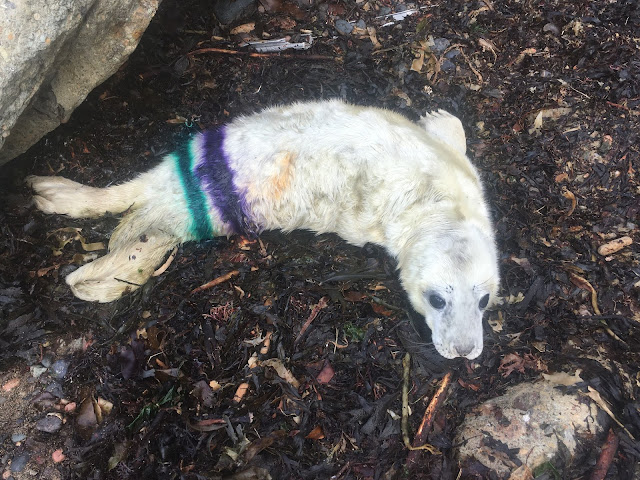Skomer is a small island off the Pembrokeshire coast that is managed by the Wildlife Trust for South-West Wales. The island contains 350,000 pairs of Manx Shearwaters (half the world population) however, it is better known for its Puffin population (24,000 pairs). Due to this 1000’s of tourists visit the island each year. However, due to the COVID-19 pandemic this year was very different with no visitors and only 4 people on the island; 2 wardens, a researcher and long-term volunteers (Me!). Because of this I felt very lucky to spend just over a month on the island helping out with research and general island jobs.
My main role on the island was to help in the monitoring of the grey seals that were pupping during my stay. This involved daily walks around the island to record the number of adults and pups at different sites along with recording pup size, whether moulting, if with mum and if suckling. Along with this, Skomer is one of the only locations to spray pups so they can be individually identified (using safe spray paint that is also used on farm animals). The reason spraying is only done in 2 locations in the UK is due to difficulty in accessing beaches and getting close enough to pups and the risk of disturbance leading to abandonment. That said this type of marking results in survival rates being able to be calculated which wouldn’t be possible on beaches that have large numbers of pups.
Other roles I had included bird surveys and ringing, moth trapping, vegetation clearing, surveying rockpool wildlife and cetacean watches. However, living on a remote island also meant that the jobs needing to be done ranged drastically from fixing a bird hide, cleaning accommodation, sawing firewood, cleaning the boat to helping with the delivery of gas bottles.
Being on the island in August/September coincided with the
migration of European breeding birds as they move south for winter. This meant
that everyday different species and numbers of birds were present as they
stopped off to feed. These included spotted flycatchers, willow warblers, blackcaps, robins and swallows (An incredible 858 swallows flew south through the island on the 10/9/20!). At sea, birds were also seen migrating south including wildfowl, terns and skuas. All bird records are added
to a daily bird log which can be used in research to monitor population increase/declines
in migratory species.
My time on the island can only be described as amazing! It
allowed me to gain vital experience in surveying and monitoring. I also gained
an insight into how the island is run and managed and what it takes to live and
work in a remote and harsh environment.
I am fortunate to be offered another 2½ months next year to
go back as a long-term volunteer, this will allow me to gain experience which will
be vital when I look for jobs in the future.



Comments
Post a Comment